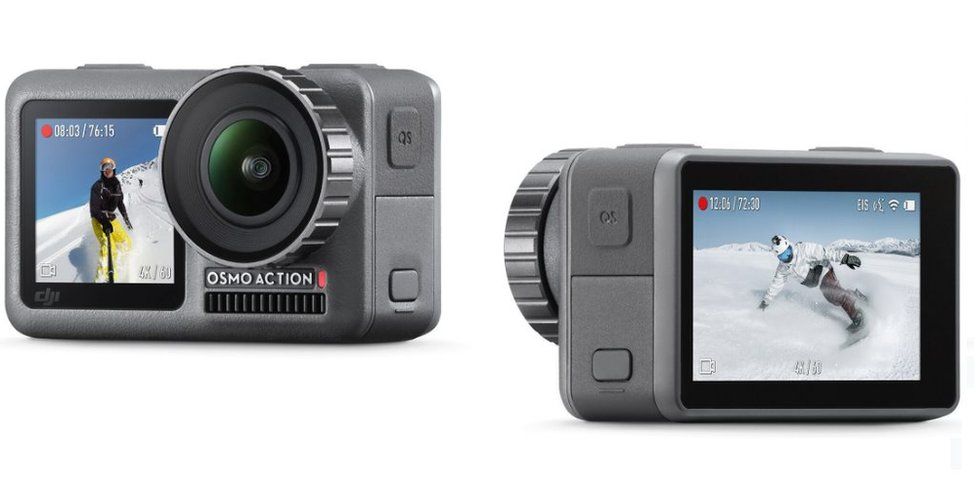DJI Osmo Action camera poses threat to GoPro
- Published

DJI has launched its first action camera posing a challenge to the market leader GoPro.
The Chinese company already dominates the consumer market for drones.
The Osmo Action uses image-stabilisation software to smooth out its video, rather than using the electronic motors found in the Osmo Pocket and other handheld gimbals.
This mirrors the approach of GoPro's Hero 7 Black. But DJI's model has the advantage of a colour front-screen.
The 1.4in display should help frame selfie photos and videos, while its rear 2.25in touchscreen is also slightly larger than that of the GoPro.
Otherwise the devices are closely matched, both offering:
- two microphones
- waterproofing
- a time lapse feature
- up to 60 frames per second 4K resolution video
- 8x slow-mo video in 1080p resolution
- 12 megapixel photos
- voice-activated controls
Camera reviewer Kaiman Wong is one of the first people to have carried out a side-by-side comparison of the competing products.
"With stabilisation, the DJI seemed a lot smoother across all five axes of movement - the footage seemed to glide along, you almost don't need a gimbal now," he told the BBC.
"And the front screen is pretty good. It doesn't show the full width of the shot, but it's good to know when you are in frame. For vloggers, myself included, it's a very useful feature to have."
WATCH: The BBC tested the GoPro Hero 7 Black last year
He added that so far he had found few downsides to the newer device.
"There is a slight lag in the DJI's display when using the stabilisation, but you can live with it and it may not be an issue [after a software update]."
Other reviewers have noted that the Osmo Action lacks GPS location-tracking and has more basic facilities to share images to social media.
It is also unable to live-stream footage via a smartphone app, which the GoPro flagship can do.
Action sports
GoPro has become synonymous with the market for action cameras, which are targeted at snow-boarders, surfers, sky divers, and other extreme sports enthusiasts as well as professionals who do not want to risk more expensive equipment in high-risk shoots.
As smartphones have become more rugged and waterproof, this market has become squeezed. The Hero 7's built-in stabilisation had become a key driver to convince existing owners to upgrade.
DJI will sell the Osmo Action for £329 when it begins deliveries this week.
That is £50 below the cost of the Hero 7 Black. However, GoPro is currently bundling a microSD card, which helps narrow the difference.
Under pressure
The seventh-generation Hero helped the US firm post its first quarterly profit in more than a year in February, although it subsequently fell back into a loss over the following three months.
Having ditched its own drone business last year and not updated its 360-degree Fusion camera since it was unveiled in September 2017, GoPro is now heavily dependent on its action cameras to drive revenues.
As a private company, Shenzhen-based DJI does not release equivalent financial data of its own, and has a wider portfolio of products to fall back on.
In its favour, GoPro has established widespread distribution deals with physical retailers, making its cameras a common sight in high street stores.
But Mr Wong said DJI's entry into the market would put the American firm under pressure ahead of its next product cycle.
"The changes made to the last three to four evolutions of GoPro's action cameras have not been groundbreaking," he explained.
"And anything that GoPro does now may almost seem like a 'we-can-do-that-too' response to DJI."